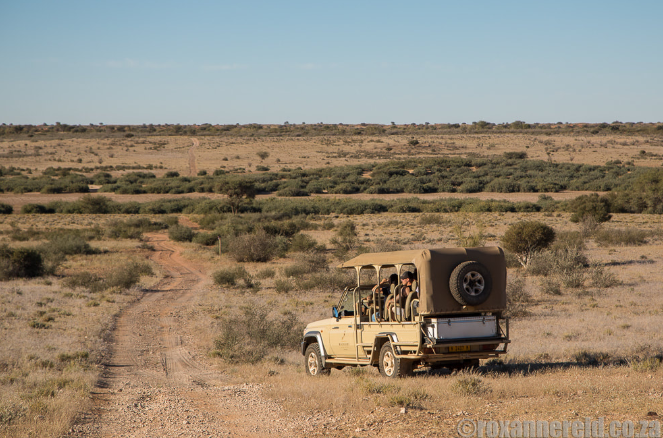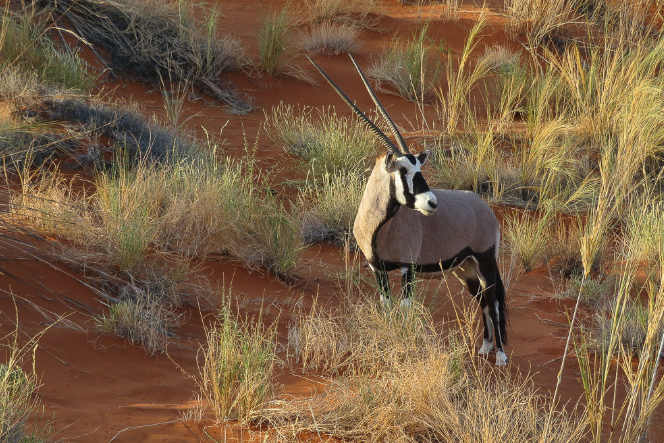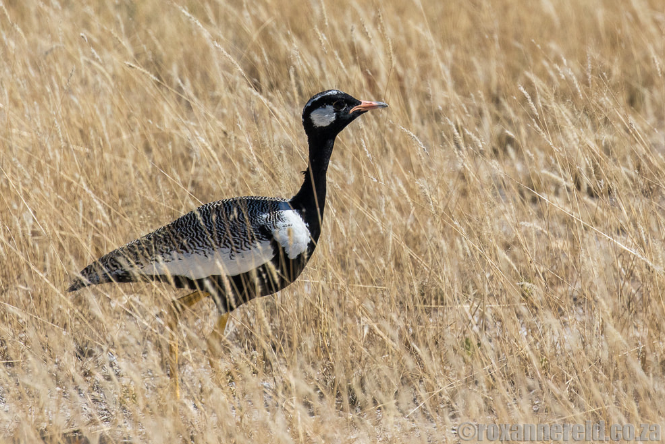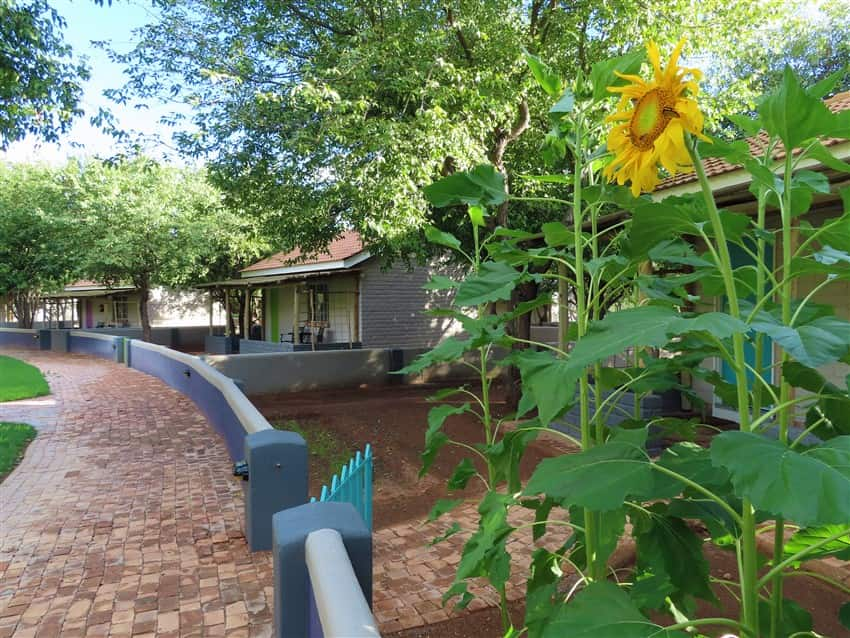This is the thirstland, a place of thorn trees, giant weavers’ nests and creatures adapted to life among the red sand dunes. It’s the Kalahari in south-eastern Namibia and it’ll share its wonders with anyone who looks with an open spirit. When you visit Kalahari Anib Lodge near Mariental, don’t miss the chance to enjoy a sundowner drive in Namibia and feel the Kalahari's heart beat.
The 10,000-hectare Gondwana Kalahari Park where Kalahari Anib Lodge stands is home to many Kalahari species, though not lions or cheetahs. You may, however, spot black-backed jackal, bat-eared fox, African wild cat or aardwolf, especially at night or around dawn or dusk. There are also lots of antelope, giraffe and zebra.
We joined guide Levi Newili on a nature drive late one afternoon, jogging along sandy roads in the 4x4 and discovering how termite mounds pepper the earth. ‘Termites are self-organised and make the mound using saliva to stick sand particles together one by one,’ he said. ‘The queen is for reproduction only, not to control or direct the termites. The structure you see above ground is used for temperature regulation and as a lung to allow oxygen in and get rid of carbon dioxide, but the termites actually live entirely underground.’
That Kalahari feeling
Go on a walk or a nature drive here and you’ll quickly realise that the Kalahari is almost as much a feeling as it is a place. When the vehicle stops so you can watch ground squirrels shading themselves with their bushy tails, ostriches taking a dust bath, or a herd of red hartebeest loping along a ridge of a dune, be still for a moment, feel the heat begin to seep from the day, smell the dust and the grass, perhaps hear the yelp of a jackal.
These are moments to treasure, when you realise why many people’s eyes soften with memories when you say the word ‘Kalahari’. It’s not just a nature experience, but a spiritual one.
Mammals and birds
We watched springbok pronking across the veld, their backs arching, legs stiff, all four hooves hitting the ground at once in what appears to be an impossible feat. We admired the horns and colouring of the gemsbok – Namibia’s national animal. They’re ingenious browsers who get enough water from wild melons and have a special system to cool the blood to their brains, making them well adapted to semi-arid conditions.
A herd of zebras showed off a small foal of two or three months old, still as fuzzy as a children’s stuffed toy. ‘Zebras are unselective feeders so they often maintain condition even when there is less to feed on,’ said Levi. In other words, here in the Kalahari beggars can’t be choosers.
Blue wildebeest kicked up dust nearby. If you’re lucky, you might even see the stately giraffe snacking on the treetops or Africa’s largest antelope, the eland, which can weigh up to a whopping 900kg.
We stopped to watch a black korhaan strut through the veld and saw it take to the air in a clatter of noise. For this behaviour, they’re known as the alarm of the bush, helping to alert other creatures to danger.
You might also see the kori bustard walking slowly through the veld foraging for a tasty insect or small lizard. They’re partial to tree gum too (in Afrikaans the bird is known as the gompou, or gum peacock). A San guide once told us that hunters used to tie a bit of gum to a thong and attach the other end to the tree. Once the bustard swallowed the gum, it became attached to the tree by the thong until the San came back licking their lips for a good dinner.
Learning about plants
The rainy season here in the Kalahari is from December to April, and 57mm fell about six weeks before our May visit, bringing life and some greenness to the veld. ‘But the veld is still stressed because there has been little other rain this year,’ Levi said.
What I love about a nature drive like this is that it’s not all about big game. There’s a chance to meet and learn about some of the plants and smaller creatures too.
Take the trumpet thorn bush, for instance. A spiny shrub about a metre or two high, with greyish leaves, it’s named for the sweetly scented whitish-pink tubular flowers that festoon the bushes in spring. The San chew the roots for stomach ailments and use the sticks to rub together to make fire, as well as for their arrows. It’s also called the papwielbos (flat tyre bush) thanks to its thorns that can reach up to 50mm long.
Levi also talked about the classic Kalahari special, the shepherd’s tree, or witgat, which is common in the dunes. The leaves are highly nutritious and have many medicinal uses. The plant also plays a vital ecological role in the Kalahari, creating a cavern of shade. The temperature under one of these trees can be as much as 20 degrees cooler than in the sun. That’s welcome relief in an area where daytime temperatures in summer can reach up to 50 degrees Celsius.
Its cousin, the smelly shepherd’s tree or stink bush, is more common in rocky areas. Although flowers that appear in spring and summer have an unpleasant smell, the berries are sweet and much loved by the San and birds alike. The San also ferment the berries to make traditional beer, while smoke from burning the branches helps them communicate with the ancestors.
A large sociable weavers’ nest containing some 200 birds was another opportunity to learn something. Communal colonies of these birds can be anything from 10 to 500 all living together in an inventive, temperature-controlled structure. They use the grass under the tree – often a camel thorn – to build their nest and will reuse it if the nest breaks and falls.
‘This is clever, because less grass under the tree gives better visibility to protect against danger from snakes,’ said Levi. Rosy-faced lovebirds also use the nests and have a symbiotic relationship with the weavers because they give a high-pitched shriek to warn when a snake approaches. A similar relationship with the pygmy falcon helps to chase away small snakes, though the weavers pay the price for that protection when the falcon eats eggs and baby birds.
Sundowners on a dune
As the sun began to set, a small family of kudu stood backlit on top of a dune. We drove to the crest of a dune with a view and piled out to feel the cooling Kalahari sand between our toes while Levi readied a table of drinks and snacks.
From our vantage point we marvelled at swathes of silky Bushman grass nodding in the late afternoon sun, the burble of Namaqua sandgrouse as they flew overhead, the last flare of the sun before it settled behind a dune and colours on the horizon began to deepen.
Gin and tonic in hand, I couldn’t think of a better way to end a day in the Kalahari. Hence, a sundowner drive is a must do when staying at the Kalahari Anib Lodge or Kalahari Farmhouse.
Writer: Roxanne Reid is a freelance writer, photojournalist, blogger, editor and proofreader. As a travel writer, she has walked through the Kalahari with a San tracker, camped under the stars in the bare stillness of the Richtersveld, and drove along the Roof of Africa in the high mountains of Lesotho. She also enjoyed breakfast in the Okavango Delta with a herd of elephants, walked among the wild horses of the Namib Desert and felt the spray of the Victoria Falls on her face.
Have you experienced a sundowner drive in Namibia’s Kalahari before? Share some of your favourite sundowner drive experiences in the comment section below.










SUBMIT YOUR COMMENT